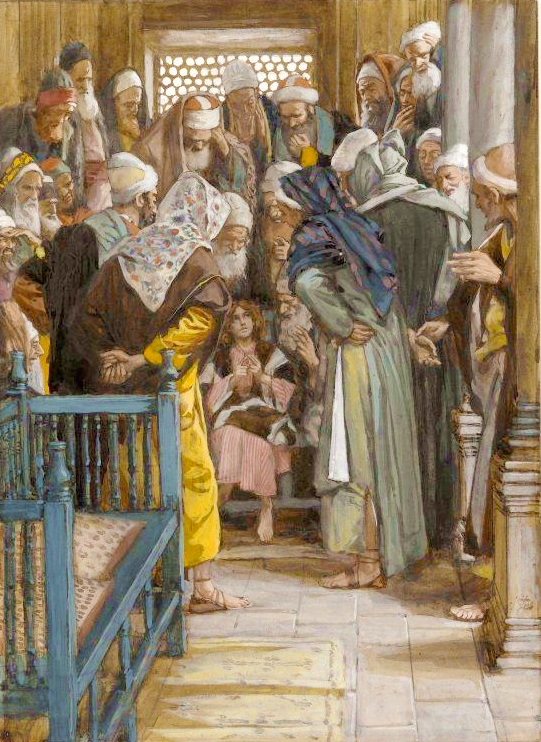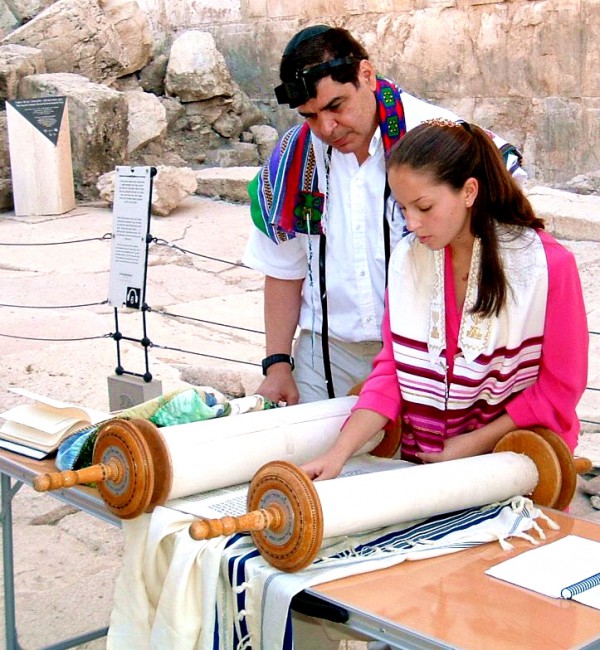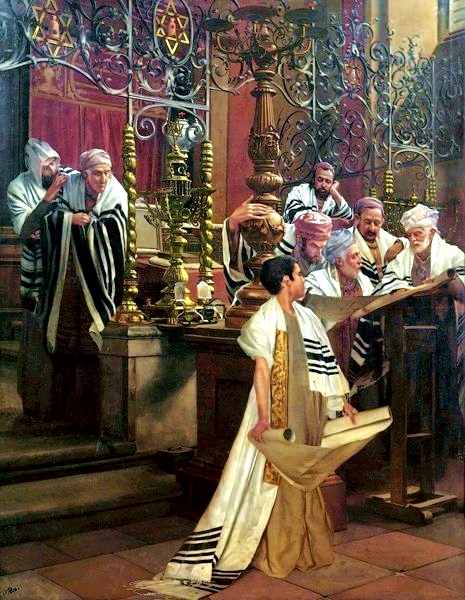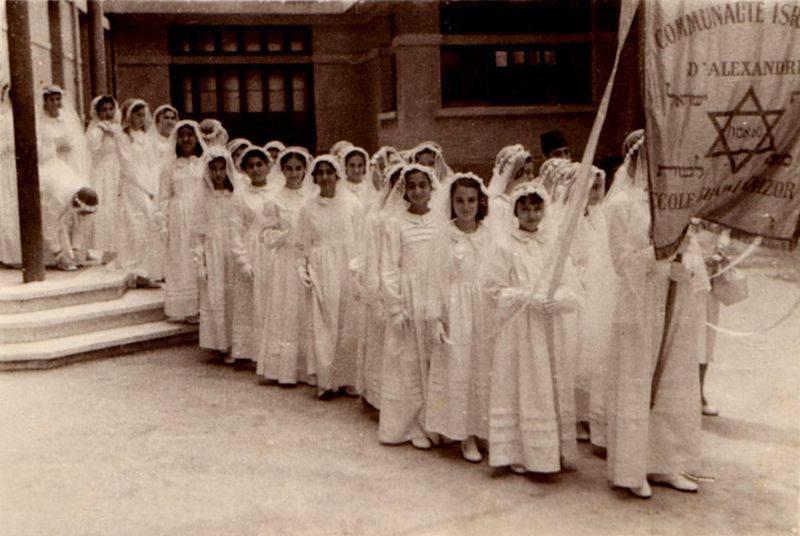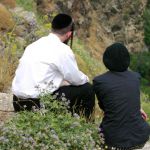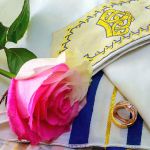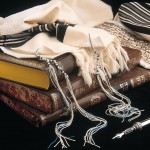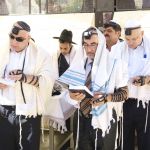“After three days they found Him [Yeshua] in the temple courts, sitting among the teachers, listening to them and asking them questions.” (Luke 2:46)
The Bar/Bat Mitzvah is a milestone in Jewish life. It not only tells the world that the child has reached adulthood and ist taking greater responsibility for his or her actions, it strengthens his or her identity as a Jew.
In Jewish law, Jewish girls (at age 12) and boys (at age 13) become responsible for observing Jewish ritual law, traditions and ethics. The rite of passage associated with this observance is the Bar Mitzvah for boys and Bat Mitzvah for girls.
Bar Mitzvah literally means son of commandment and Bat Mitzvah means daughter of commandment. However, the term in rabbinical usage has come to mean one who is subject to the law.
Once they are subject to the law, boys and girls are free to participate in all areas of Jewish community life, as we’ll read about further on in this feature article.
Although the ceremony today differs from its ancient past and only became a unanimously accepted Jewish custom some 400 years ago, in the Gospels we read that Yeshua (Jesus) was examined by the Temple priests and teachers at the age of 12. (Luke 2:41–52)
The Brit Chadashah (New Testament) tells us that His knowledge was extraordinary and that “all who heard Him were amazed at His understanding and His answers.” (Luke 2:47)
This may indicate that even the Messiah was Bar Mitzvahed, passing through the rites of His day. As one of few events recorded about His early life, Scripture certainly highlights this event as important.
It is, perhaps, the oldest record of a Bar Mitzvah.
Today, the Bar and Bat Mitzvah is a central rite of passage for all Jewish people, including Jewish Believers in Messiah.
Marty Goetz: A Jew Born Anew
Well I had a Bar Mitzvah when I was thirteen,
the greatest Bar Mitzvah that you’ve ever seen.
The temple on the corner of Mayfield and Lee
was filled with my friends and my family,
all of them proud as proud could be,
with catering far as the eye could see—
complete with a chopped liver statue of me!
(Lyrics excerpted from the song “A Jew Born Anew”
© 2011 Marty Goetz Ministries)
Marty Goetz is a good Jewish boy who grew up in Cleveland, Ohio in a relatively observant Jewish family.
He is also a well-known Messianic performer of psalms and praise music. In the above lyrics, he sings about his introduction into the status of manhood in his local synagogue. The song suggests he had a rather positive experience.
But after describing his wonderful Bar Mitzvah, he suddenly laments, “And they won’t let me get Bar Mitzvahed again.”
This is a common experience for young Jewish men who find themselves the center of attention of their Jewish congregation for one brief day, complete with a showering of gifts and praises, only to have to go through life afterword just like everyone else, usually never again enjoying such attention and praise.
Aware that something was missing in his life, Marty found wholeness when he invited the greatest Jew who ever lived (and still lives) into his life, which prompted writing this song.
The Development of a Tradition
There is really no clear basis for the tradition of a Bar Mitzvah, nor is there a command in the Torah (Five Books of Moses) to observe one.
One opinion in the Midrash (compilation of Rabbinic teachings), however, traces the source of the tradition to Genesis 21:8: “And the child [Isaac] grew and was weaned, and Abraham made a great feast on the day that Isaac was weaned.”
The Midrash states that this weaning brought Isaac into manhood at the age of 13. This opinion has since found its way into much Jewish literature. (Chabad)
As it is practiced today, at the age of 13, a boy is considered to be a man and is now responsible to keep all of the commandments.
Thirteen is also the age at which his vow is now valid.
The Talmud (Niddah 5:6) rules that from the age of 12, the vow of a girl is valid which is why girls are Bat Mitzvahed at age 12.
This is also the age at which they become accountable for their own actions.
It is only in mid-20th century America, however, that the Bat Mitzvah ceremony has become identical to the Bar Mitzvah celebration.
Beginning in the 19th century in regions such as Eastern and Western Europe, Egypt, and Baghdad, recognition of the girl’s coming of age was celebrated with a private blessing, a father’s aliyah to the Torah (going up to the bimah to read the Torah), the sermon given by the rabbi, and the girl’s public examination on Judaic subjects. (Jewish Virtual Library)
Marriage and Other Privileges
By rabbinic tradition, a Bat Mitzvahed girl is minimally qualified to marry, although 18 is considered the proper age for marriage and 20 is the age for venturing out to earn a livelihood.
Also at this age, boys may now serve as the cantor or chazzan in the synagogue and be called to read the Haftarah (Prophetic Reading) from the book of prophets.
And among observant Jews, a young Bar Mitzvahed man begins to wear the tefillin (phylacteries) during morning prayers. He can now read from the Torah in the synagogue and be granted an aliyah.
He can also lead grace after meals and be counted as a part of a minyan (the required quorum of 10 for corporate prayer). If the boy is a kohen (descendant of Aaron), he can pronounce the priestly blessing.
He must also now participate in fasting on fast days, such as Yom Kippur (Day of Atonement) and the Fast of Esther the day before Purim.
“The thrill of attention received on my Bar Mitzvah was extended when the rabbi trained me to lead the Friday night services as the chazzan and to chant the Haftarah on Shabbat mornings. Of course these are activities that any male may perform after having been Bar Mitzvahed as long as he is able,” said Barry, a member of the Bibles For Israel team.
“I was also able to use the Jewish literacy skills that I attained through learning my Bar Mitzvah Haftarah reading to train others, some of whom are Messianic Jews including my own son.”
Messianic Believers most often find that synagogues are unwilling to Bar Mitzvah their children. Moreover, becoming a Jewish Believer can result in Bar Mitzvah rights and privileges being stripped in the local synagogue.
“I apparently lost my Bar Mitzvah rights, however, when I revealed my belief in Yeshua to the rabbi in Cincinnati where I lived. As far as he was concerned, I was no longer a Jew and I was excluded from being counted as part of the quorum of 10,” Barry said.

A Bar Mitzvah procession at the Western (Wailing) Wall in Jerusalem, a popular spot to be Bar Mitzvahed for men of all ages.
Bar Mitzvah Preparations
A Bar Mitzvah doesn’t just happen; the boy to be Bar Mitzvahed often prepares for several years.
Barry started to prepare when he was nine.
“At the age of nine, I followed a full day of public school by taking the bus to the Hebrew Institute which was where the Jewish community’s Hebrew afterschool classes were taught for young Jewish boys and the occasional girl,” Barry said.
“It was there that I began to learn in detail what it means to be a Jew, to start wearing the undergarment called the tzitzit and to learn to read Hebrew so that I could participate in the daily rituals, starting the morning with the prayer upon rising: “Modah ani lifanecha…” (“Thank you Lord for mercifully returning to me my soul”), as well as the various prayers before eating or drinking, the prayer after meals, and the prayer before going to sleep at night.”
Barry was told that since it was necessary to pray throughout the day, he would need to keep his head covered with a kippah (yarmulka or skull cap).
“In later years, I exchanged taking the bus for peddling my English Racer bike up steep hills in all kinds of weather to get to Hebrew School. It made for long days and cold nights, but it also made me a Jew,” Barry said of his commitment to learning. “Even so, when I got to Israel I found my Hebrew skills almost nonexistent when trying to actually communicate in the language.”
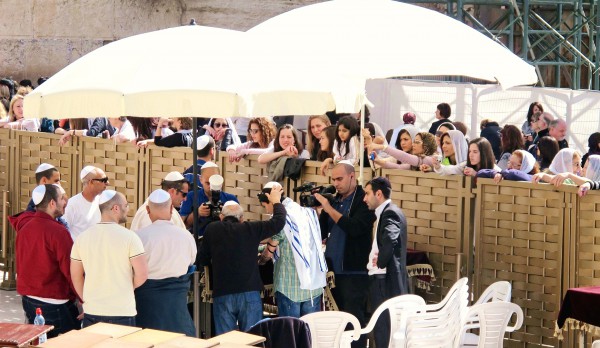
Women observe the Bar Mitzvah of a male relative from behind the fence during a Bar Mitzvah in the men’s section at the Western (Wailing) Wall. (Photo by Dan Lundberg)
Barry’s learning involved more than Hebrew language skills.
He also learned a little about Jewish life in WWII when his schoolteacher shared with him how he escaped the Warsaw Ghetto by distracting the guards into thinking that someone was trying to scale the wall that surrounded the Ghetto, and then he did so himself.
This same teacher survived the war working in a hospital.
During a bombing raid, he was praying the morning prayers wearing his tefillin and refused to go to the bomb shelter during the raid.
At the same time, a bomb fell through the roof of the hospital, traversing all of the floors but did not explode. After that, everyone thought he was a saint and responsible for the miracle that saved their lives, Barry said.

A 13-year-old Jewish boy carries the Torah scroll publicly for the first time at the Western (Wailing) Wall in Jerusalem.
Bar Mitzvahs for Adults
A good many Jewish adults who missed their Bar/Bat Mitzvah feel that they have also missed an essential piece of their God-given heritage, so they decide to celebrate it as an adult.
A popular spot for parents and adults to celebrate this occasion is at the Western Wall that once lined the Temple Mount platform in Jerusalem.
Some say that as early as Second Temple days, the Bar Mitzvah boy would be brought to the Temple courtyard to have their knowledge “tested” by the priests and elders.
In 2012, actor David Arquette, whose mother is Jewish, was Bar Mitzvahed at the Wall at the age of 40.
“He was very emotional, saying he was happy to be part of the chain of the Jewish People,” said Western Wall rabbi Shmuel Rabinowitz, who presided over the ceremony. “I’m very pleased to see a man who is returning to his roots.” (Arutz Sheva)
“I had my Bar Mitzvah today at the Wall. Finally, I’m a man,” Arquette posted online.
Messianic Bar and Bat Mitzvahs
Although Jewish Believers are saved by faith in the saving grace of Yeshua HaMashiach and not by acts, this faith does not nullify their Jewish identity.
A great many Jewish Believers train their children in Jewish prayer and practices such as the Jewish Sabbath and Jewish holidays, as well as celebrate their Bar/Bat Mitzvah, a day on which they publicly embrace God’s Word, giving their commentary on the portion and their personal testimony of faith in Yeshua HaMashiach.
Of course, this celebration is also a positive sign to nonbelieving family members that Jewish Believers have not abandoned their Judaism for “another religion.”
“My son’s Bar Mitzvah brought my aunts from Chicago to Cincinnati (a drive of several hours) along with my mother from Florida. Although my mother had come to accept our beliefs and had prayed to accept the Messiah, her sisters were very much against our believing in Yeshua. Experiencing our son’s Bar Mitzvah and its Jewishness reassured them that we had not given up our identity as Jews,” Barry reminisced.
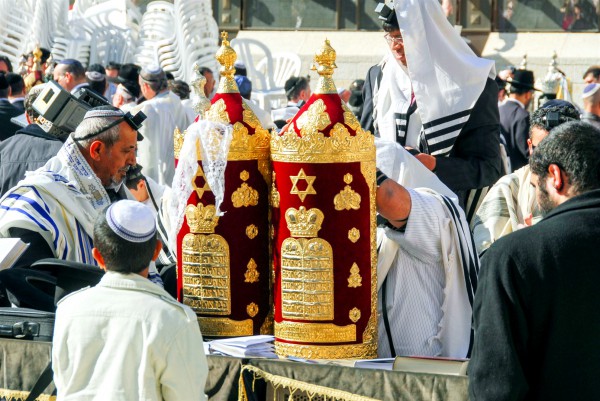
A 13-year-old Jewish boy stands before the Torah scroll during his Bar Mitzvah at the Western (Wailing) Wall in Jerusalem.
Today, many children have parents of varying backgrounds and religions. And within Judaism, there is a wide variety of ways to celebrate the occasion.
One of Barry’s sons, for instance, was Bar Mitzvahed with his class at Kibbutz Beit HaShita, a Labor Zionist kibbutz that does not follow religious practices. The entire class was Bar Mitzvahed in a group ceremony that did not involve synagogue worship or the traditional reading of the Torah; nevertheless, as far as the kibbutz was concerned, their sons were now Bar Mitzvahed.
When a family has chosen to identify as Jewish Believers in the Lord, it is important that they allow their children to pass through the stages of growth and identity that are common to all Jewish children in some formal, public celebration.
This ceremony emphasizes a child’s Jewish identity and helps to sustain a strong connection to his or her Jewish heritage. It can only strengthen a child’s desire to learn more about being Jewish and create a firmer attachment to their people, warding off a sense of alienation.
This can also foster a connection to God that will encourage a more profound relationship with their Maker as they progress into adulthood.
Being fully grounded in Judaism equips Jewish Believers to take their rightful place as part of the Jewish community, while daily developing a deeper understanding of the Jewish roots of the Good News of Yeshua our Messiah.
“For I am not ashamed of the gospel, because it is the power of God that brings salvation to everyone who believes: first to the Jew, then to the Gentile.” (Romans 1:16)





